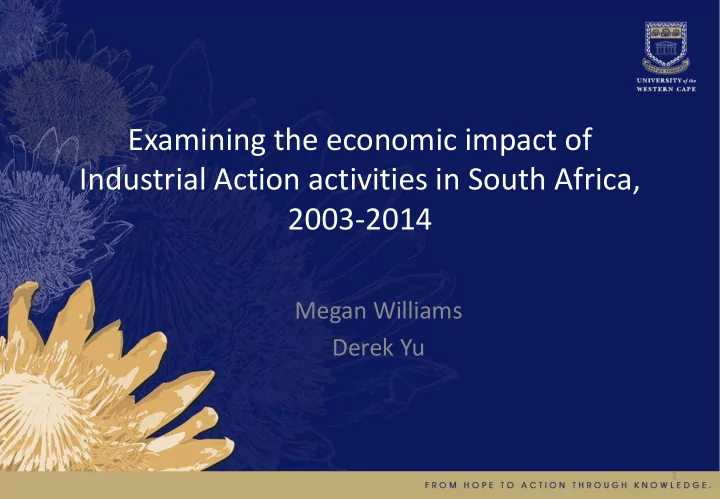

Examining the economic impact of Industrial Action activities in South Africa, 2003-2014 Megan Williams Derek Yu 1
Outline • Conceptual framework • Theoretical framework • Legislative framework • Review of past empirical studies (very few locally) • Data & Methodology • Empirical findings (descriptive & econometric) • Conclusion (verbally…) 2 2
Conceptual framework • Industrial action: a general term which represents the action by one party (e.g. employees) in the furtherance of an industrial dispute so as to pressurise the other party (e.g. employers) • Work stoppage: an action initiated by either the employees (in the form of a strike) or employers (in the form of a lockout) • Strike: partial or complete refusal to work, or work obstruction, by employees. This happens as the workers would like to remedy a grievance or resolve a dispute in respect of any matter of mutual interest between workers and employers • Lockout: exclusion by an employer of workers from the employer’s workplace, to compel the workers to accept a demand in respect of any matter of mutual interest between employer and workers 3
Conceptual framework • Secondary strike: A strike in support of another strike by other workers against their employer • Stayaway action: work absenteeism of a group of workers without permission in support of a socio-economic or socio-political issue who may not be related to their employment situation • Picketing: action by workers to publicise the existence of an industrial dispute by standing or patrolling outside the location where the dispute takes place (usually with placards which indicate the nature of the dispute) 4
Theoretical framework – Hicks Paradox model 5
Theoretical framework – Hicks model of strike duration The firm’s concession curve (CC) is its maximum offer at each point during the strike The union’s resistance curve (RR) signifies the lowest wage that unions will agree to take 6
Legislative framework (very brief…) • 1995 Labour Relations Act (LRA) – Entitlement of workers and employers to strikes and lockouts respectively – Promotion of collective bargaining at sectoral level and employee participation at the workplace – Promotion of dispute resolution and labour peace 7
Review of past local empirical studies • Jacobs and Yu (2013) – highly descriptive • Van der Velden & Visser (2006) – highly descriptive (despite proposing 2 interesting strike composite indices) • Wood & Glaister (2008) – involve a primary survey • Schoeman, Botha & Blaauw (2010) – time-series study • Bhana (1997) – strikes vs. share prices • Bohlmann, Dixon, Rimmer & Van Heerden (2014) – complicated CGE model • Jordaan (2016) – complicated SAM model 8
Review of past international empirical studies • Using firm-level survey data (not available in RSA…) : – how strikes affect wage – factors affecting strike probability – relationship between strike frequency, strike duration, wages and labour relations – relationship between strikes and business cycles • Strike probability is procyclical • Strike frequency is procyclical • Strike outcome is procyclical (favouring workers) • Strike duration is counter-cyclical 9
Data • Labour data (weekly work hours, monthly income) – 1995-1999 October Household Survey (OHS) – 2000-2007 Labour Force Survey (LFS) – 2008-2016 Quarterly Labour Force Survey (QLFS) – 2005-2016 Quarterly Employment Statistics (QES) • GDP/GVA and business cycle macro data – SARB Quarterly Bulletin online database • Strike data – 2003-2014 Industrial Action Reports (very precise info for 1999-2014, by industry) – ILO Labour Statistics Database (on # of strikes, # of workers involved in strikes, # of work days lost due to strikes for 1970- 1998) 10
Methodology • Detailed descriptive statistics (1999-2014) [By broad industry category] • Number of strikes (N) • Number of workers involved (S) • Total work hours lost • Total work days lost (D) • Time-loss ratios (to be explained later) • Principle causes of disputes • Top trade unions involved in strikes 11
Methodology • GVA foregone due to strikes [Static analysis] Example: (H): work hours lost due to strikes in manufacturing = 3 000 hours (w-bar): mean hourly wage in manufacturing = R100 / hour Total value of production foregone due to strikes = 3 000 × R100 = R300 000 12
Methodology • Whether strikes are procyclical [Static analysis] This is followed by the regression: Composite strike indicator = f(Business cycle index) 13
Empirical findings – descriptive statistics Fewer strikes since 1998 – as workers are now better protected thanks to the introduction of the 1995 LRA? 14
Empirical findings – descriptive statistics 15
Empirical findings – descriptive statistics 16
Empirical findings – descriptive statistics 17
Empirical findings – descriptive statistics Time-loss ratio = (# of work days lost / # of formal sector employees) × 1 000 18
Empirical findings – descriptive statistics NUM: National Union of Mineworkers SATAWU: South African Transport and Allied Workers Union 19
Empirical findings – descriptive statistics 20
Empirical findings – GVA foregone by industry 21
Empirical findings – GVA foregone by industry 22
Empirical findings – Econometric analysis • Each strike composite indicator is regressed on the following explanatory variables: – Business cycle coincident indicator (CI) (+) – A dummy variable that is equal to 1 for the years when there were significant changes in labour legislation (+) – A dummy variable that is equal to 1 for 1995-2014. With the advent of democracy and the new 1995 ( – ) – Real interest rate: there is a positive relationship between real interest rate and strikes (+) 23
Empirical findings – Econometric analysis 24
Recommend
More recommend